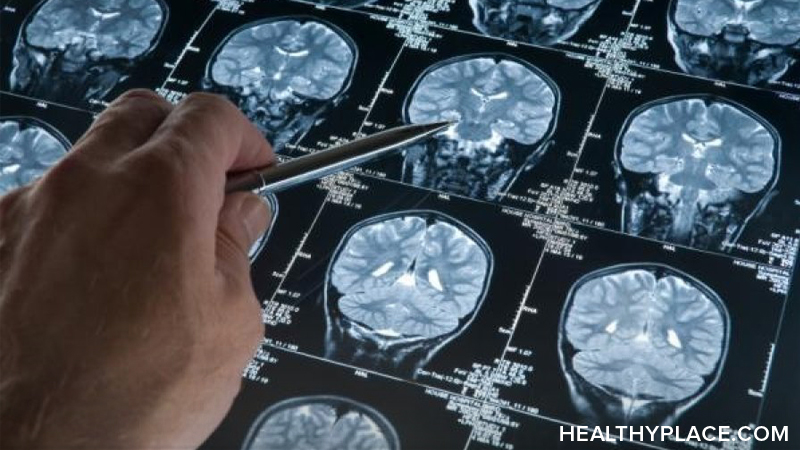Schizophrenia Overview

An in-depth overview of schizophrenia including symptoms, causes, treatments of schizophrenia. Also resources for schizophrenia patients and family members.
What is Schizophrenia
One of the most stigmatized and debilitating mental illnesses is Schizophrenia. Though it has a specific set of symptoms, Schizophrenia varies in its severity from individual to individual, and even within any one afflicted individual from one time period to another.
The symptoms of schizophrenia generally can be controlled with treatment and, in more than 50 percent of individuals given access to continuous schizophrenia treatment and rehabilitation over many years, recovery is often possible. Though researchers and mental health professionals don't know what causes schizophrenia, they have developed treatments that allow most persons with schizophrenia to work, live with their families and enjoy friends. But like those with diabetes, people with schizophrenia probably will be under medical care for the rest of their lives.
Symptoms of Schizophrenia
Generally, schizophrenia begins during adolescence or young adulthood. The symptoms of schizophrenia appear gradually and family and friends may not notice them as the illness takes initial hold. Often, the young man or woman feels tense, can't concentrate or sleep, and withdraws socially. But at some point, loved ones realize the patient's personality has changed. Work performance, appearance and social relationships may begin to deteriorate.
As the illness progresses, the symptoms often become more bizarre. The patient develops peculiar behavior, begins talking in nonsense, and has unusual perceptions. This is the beginning of psychosis. Psychiatrists diagnose schizophrenia when a patient has had active symptoms of the illness (such as a psychotic episode) for at least two weeks, with other symptoms lasting six months. In many cases, patients experience psychotic symptoms for many months before seeking help. Schizophrenia seems to worsen and become better in cycles known as relapse and remission, respectively. At times, people suffering from schizophrenia appear relatively normal. However, during the acute or psychotic phase, people with schizophrenia cannot think logically and may lose all sense of who they and others are. They suffer from delusions, hallucinations or disordered thinking and speech.
Positive and Negative Symptoms of Schizophrenia
Delusions and hallucinations are referred to as "positive symptoms" of schizophrenia
Delusions are thoughts that are fragmented, bizarre and have no basis in reality. For example, people suffering from schizophrenia might believe that someone is spying on or planning to harm them or that someone can "hear" their thoughts, insert thoughts into their minds, or control their feelings, actions or impulses. Patients might believe they are Jesus, or that they have unusual powers and abilities.
People suffering from schizophrenia also have hallucinations. The most common hallucination in schizophrenia is hearing voices that comment on the patient's behavior, insult the patient or give commands. Visual hallucinations, such as seeing nonexistent things and tactile hallucinations, such as a burning or itching sensation, also can occur.
Patients also suffer disordered thinking in which the associations among their thoughts are very loose. They may shift from one topic to another completely unrelated topic without realizing they are making no logical sense. They may substitute sounds or rhymes for words or make up their own words, which have no meaning to others.
These symptoms don't mean people with schizophrenia are completely out of touch with reality. They know, for example, that people eat three times a day, sleep at night and use the streets for driving vehicles. For that reason, their behavior may appear quite normal much of the time.
However, their illness does severely distort their ability to know whether an event or situation they perceive is real. A person with schizophrenia waiting for a green light at a crosswalk doesn't know how to react when he hears a voice say, "You really smell bad." Is that a real voice, spoken by the jogger standing next to him, or is it only in his head? Is it real or a hallucination when he sees blood pouring from the side of the person next to him in a college classroom? This uncertainty adds to the terror already created by distorted perceptions.
Psychotic symptoms of schizophrenia may lessen--a period during which doctors say the patient is in the residual stage or remission. Other symptoms, such as social withdrawal, inappropriate or blunted emotions, and extreme apathy, may continue during both these periods of remission and periods when psychosis returns--a period called relapse and may persist for years. People with schizophrenia who are in remission still may not be mentally able to bathe or dress appropriately. They may speak in a monotone and report that they have no emotions at all. They appear to others as strange, disconcerting people who have odd speech habits and who live socially marginal lives.
Cognitive deficits include impairment in attention, processing speed, working memory, abstract thinking, problem-solving, and understanding social interactions. The patient's thinking may be inflexible, and the ability to problem solve, understand the viewpoints of other people, and learn from experience may be diminished.
There are many types of schizophrenia. For example, a person whose symptoms are most often colored by feelings of persecution is said to have "paranoid schizophrenia;" a person who is often incoherent but has no delusions is said to have "disorganized schizophrenia." Even more disabling than the delusions and hallucinations are the symptoms of "negative" or "deficit" schizophrenia. Negative or deficit schizophrenia refers to the lack or absence of initiative, motivation, social interest, enjoyment and emotional responsiveness. Because schizophrenia can vary from person to person in intensity, severity and frequency of both psychotic and residual symptoms, many scientists use the word "schizophrenia" to describe a spectrum of illnesses that range from relatively mild to severe. Others think of schizophrenia as a group of related disorders, much as "cancer" describes many different but related illnesses.
Schizophrenia and Violence
Schizophrenia is a relatively modest risk factor for violent behavior. Threats of violence and minor aggressive outbursts are far more common than seriously dangerous behavior. Patients more likely to engage in significant violence include those with substance abuse, persecutory delusions, or command hallucinations and those who do not take their prescribed drugs. Very rarely, a severely depressed, isolated, paranoid person attacks or murders someone whom he perceives as the single source of his difficulties (eg, an authority, a celebrity, his spouse). Patients with schizophrenia may present in an emergency setting with threats of violence to obtain food, shelter, or needed care.
Some Numbers
Approximately 2.2 million American adults have schizophrenia. About 24 million people worldwide suffer from schizophrenia; meaning about 150 of every 100,000 persons will develop schizophrenia. Schizophrenia affects men and women equally, however, its onset in women is typically five years later than with men. Though it is a relatively rare illness, its early age of onset and the lifelong disability, emotional and financial devastation it brings to its victims and their families make schizophrenia one of the most catastrophic mental illnesses. Schizophrenia fills more hospital beds than almost any other illness, and Federal figures reflect the cost of schizophrenia to be from $30 billion to $48 billion in direct medical costs, lost productivity and Social Security pensions. According to the World Health Organization, more than 50% of persons worldwide with schizophrenia are not receiving appropriate care.
Theories About the Causes of Schizophrenia
Theories about the causes of schizophrenia abound, but research hasn't pinpointed the origins.
In years past, psychiatric researchers theorized that schizophrenia arose from bad parenting. A cold, distant and unfeeling mother was called "schizophrenigenic" because it was believed that such a mother could, through inadequate care, cause the symptoms of schizophrenia. This theory has been discredited today.
Most scientists now suspect that people inherit a susceptibility to the illness, which can be triggered by environmental events such as a viral infection that changes the body's chemistry, a highly stressful situation in adult life, or a combination of these.
While scientists have long known that the illness runs in families, much of the recent research evidence supports the linking of schizophrenia to heredity. For example, studies show that children with one parent suffering from schizophrenia have an 8 to 18 percent chance of developing the illness, even if they were adopted by mentally healthy parents. If both parents suffer from schizophrenia, the risk rises to between 15 and 50 percent. Children whose biological parents are mentally healthy but whose adoptive parents suffer from schizophrenia have a one percent chance of developing the disease, the same rate as the general population.
Moreover, if one identical twin suffers from schizophrenia, there is a 50 to 60 percent chance that the sibling--who has identical genetic make-up also has schizophrenia.
But people don't inherit schizophrenia directly, as they inherit the color of their eyes or hair. Like many genetically related illnesses, schizophrenia appears when the body is undergoing the hormonal and physical changes of adolescence. Genes govern the brain's structure and biochemistry. Because structure and biochemistry change dramatically in teen and young adult years, some researchers suggest that schizophrenia lies "dormant" during childhood. It emerges as the body and brain undergo changes during puberty.
Certain genetic combinations could mean a person doesn't produce a certain enzyme or other biochemical, and that deficiency produces illnesses ranging from cystic fibrosis to, possibly, diabetes. Other genetic combinations could mean that specific nerves don't develop correctly or completely, giving rise to genetic deafness. Similarly, a genetically determined sensitivity could mean the brain of a person with schizophrenia is more prone to be affected by certain biochemicals, or that it produces inadequate or excessive amounts of biochemicals needed to maintain mental health. Genetically determined triggers could also the development of part of the brain of a person with schizophrenia, or could cause problems with the way the person's brain screens stimuli, so that the person with schizophrenia is overwhelmed by sensory information which normal people can easily handle.
These theories arise from the ability of researchers to see the structure and activity of the brain through very sophisticated medical technology. For example:
- Using computer images of brain activity, scientists have learned that a part of the brain called the prefrontal cortex--which governs thought and higher mental functions--"lights up" when healthy people are given an analytical task. This area of the brain remains quiet in those with schizophrenia who are given the same task. Magnetic resonance imaging (MRI) and other techniques have suggested that the neural connections and circuits between the temporal lobe structures and the prefrontal cortex may be have an abnormal structure or may function abnormally.
- The prefrontal cortex in the brains of some schizophrenia sufferers appears to have either atrophied or developed abnormally.
- Computed axial tomography or CAT scans have shown subtle abnormalities in the brains of some people suffering from schizophrenia. The ventricles--the fluid-filled spaces within the brain--are larger in the brains of some people with schizophrenia.
- Successful use of medications that interfere with the brain's production of a biochemical called dopamine indicates that the brains of those with schizophrenia are either extraordinarily sensitive to dopamine or produce too much dopamine. This theory is strengthened by observing treatment for Parkinson's disease, caused by too little dopamine. Parkinson's patients, who are treated with medication that helps increase the amount of dopamine, may also develop psychotic symptoms.
Schizophrenia is similar in several respects to "autoimmune" illnesses -disorders like multiple sclerosis (MS) and amyotrophic lateral sclerosis (ALS or Lou Gherig's disease), caused when the body's immune system attacks itself. Like the autoimmune diseases, schizophrenia is not present at birth but develops during adolescence or young adulthood. It comes and goes in cycles of remission and relapse, and it runs in families. Because of these similarities, scientists suspect schizophrenia could fall into the autoimmune category.
Some scientists think genetics, autoimmune illness and viral infections combine to cause schizophrenia. Genes determine the body's immune reaction to viral infection. Instead of stopping when the infection is over, the genes tell the body's immune system to continue its attack on a specific part of the body. This is similar to the theories about arthritis, in which the immune system is thought to attack the joints.
The genes of people with schizophrenia may tell the immune system to attack the brain after a viral infection. This theory is supported by the discovery that the blood of people with schizophrenia contains antibodies--immune system cells--specific to the brain. Moreover, researchers in a National Institute of Mental Health study found abnormal proteins in the fluid that surrounds the brain and spinal cord in 30 percent of people with schizophrenia but in none of the mentally healthy people they studied. These same proteins are found in 90 percent of the people who have suffered herpes simplex encephalitis, an inflammation of the brain caused by the family of viruses that causes warts and other illnesses.
Finally, some scientists suspect a viral infection during pregnancy. Many people suffering from schizophrenia were born in late winter or early spring. That timing means their mothers may have suffered from a slow virus during the winter months of their pregnancy. The virus could have infected the baby to produce pathological changes over many years after birth. Coupled with a genetic vulnerability, a virus could trigger schizophrenia.
Most psychiatrists today believe that the above--genetic predisposition, environmental factors such as viral infection, stressors from the environment such as poverty and emotional or physical abuse--form a constellation of "stress factors" that should be taken into account in understanding schizophrenia. An unsupportive home or social environment and inadequate social skills can bring on schizophrenia in those with genetic vulnerability or cause relapse in those already suffering with the disease. Psychiatrists also believe these stress factors can often be offset with "protective factors" when the person with schizophrenia receives proper maintenance doses of antipsychotic medication, and help in creating a secure network of supportive family and friends, in finding a steady and understanding place of employment, and in learning necessary social and coping skills.
Treatment of Schizophrenia
Antipsychotics, rehabilitation with community support services, and psychotherapy are the major components of treatment.
When treated early, schizophrenia patients tend to respond more quickly and fully. Without ongoing use of antipsychotics after an initial episode, 70 to 80% of patients have a subsequent episode within 12 months. Continuous use of antipsychotics can reduce the 1-year relapse rate to about 30%. Because schizophrenia is a long-term and recurrent illness, teaching patients self-management skills is a significant overall goal.
Antipsychotic Medication for Treating Schizophrenia
Psychiatrists have found a number of antipsychotic medications that help bring biochemical imbalances closer to normal. The medications significantly reduce the hallucinations and delusions and help the patient maintain coherent thoughts. Like all medications, however, antipsychotic drugs should be taken only under the close supervision of a psychiatrist or other physician.
Antipsychotics are broken down into two categories: Typical or conventional antipsychotics are the older antipsychotic medications. These include Chlorpromazine, Thioridazine, Trifluoperazine, Fluphenazine, Haloperidol and others. About 30% of patients with schizophrenia do not respond to conventional antipsychotics, but they may respond to Atypical or second-generation antipsychotics. These include Abilify, Clozaril, Geodon, Risperdal, Seroquel, and Zyprexa.
The reported advantages of atypical antipsychotics is that they tend to alleviate positive symptoms; may lessen negative symptoms to a greater extent than do conventional antipsychotics (although such differences have been questioned); may cause less cognitive blunting; are less likely to cause extrapyramidal (motor) adverse effects; have a lower risk of causing tardive dyskinesia; and for some atypicals produce little or no elevation of prolactin.
Side Effects of Antipsychotic Medications
Like virtually all other medications, antipsychotic agents have side effects. While the patient's body adjusts to the medication during the first few weeks, he or she may have to contend with dry mouth, blurred vision, constipation and drowsiness. One may also experience dizziness when standing up due to a drop in blood pressure. These side effects usually disappear after a few weeks.
Other side effects include restlessness (which can resemble anxiety), stiffness, tremor, and a dampening of accustomed gestures and movements. Patients may feel muscle spasms or cramps in the head or neck, restlessness, or a slowing and stiffening of muscle activity in the face, body, arms and legs. Though discomforting, these are not medically serious and are reversible.
Weight gain, hyperlipidemia, and development of type 2 diabetes are among the more serious side effects of atypical antipsychotics such as Zyprexa, Risperdal, Abilify and Seroquel. Clozaril's most serious adverse effect is agranulocytosis, which can occur in about 1% of patients. Clozaril is generally reserved for patients who have responded inadequately to other drugs. Patients should be routinely monitored for all these conditions.
Because some other side effects may be more serious and not fully reversible, anyone taking these medications should be closely monitored by a psychiatrist. One such side effect is called tardive dyskinesia (TD), a condition that affects 20 to 30 percent of people taking antipsychotic drugs. TD is more common among older patients.
It begins with small tongue tremors, facial tics and abnormal jaw movements. These symptoms may progress into thrusting and rolling of the tongue, lip licking and smacking, pouting, grimacing, and chewing or sucking motions. Later, the patient may develop spasmodic movements of the hands, feet, arms, legs, neck and shoulders.
Most of these symptoms reach a plateau and do not become progressively worse. TD is severe in less than 5 percent of its victims. If medication is stopped, TD also fades away among 30 percent of all patients and in 90 percent of those younger than 40. There is also evidence that TD subsides eventually, even in patients who continue with medication. Despite the risk of TD, many suffering with schizophrenia accept medication because it so effectively ends the horrifying and painful psychoses brought on by their illness. However, the unpleasant side effects of antipsychotic medication also leads many patients to stop using medication against the advice of their psychiatrist. The refusal of patients with schizophrenia to comply with psychiatrists' treatment recommendations is a serious challenge to those specializing in the treatment of chronically mentally ill people. Psychiatrists treating people with schizophrenia must often practice with tolerance and flexibility to overcome this resistance.
Rehabilitation and Counseling for Schizophrenia Patients
By ending or reducing the painful hallucinations, delusions and thought disorders, antipsychotic medications allow a patient to gain benefit from rehabilitation and counseling aimed at promoting the individual's functioning in society. Social skills training, which can be provided in group, family or individual sessions, is a structured and educational approach to learning social relationship and independent living skills. By using behavioral learning techniques, such as coaching, modeling and positive reinforcement, skills trainers have been successful in overcoming the cognitive deficits that interfere with rehabilitation. Research studies show that social skills training improves social adjustment and equips patients with means of coping with stressors, thereby reducing relapse rates by up to 50 percent.
Another type of learning-based treatment that has been documented to reduce relapse rates is behaviorally oriented, psychoeducational family therapy. Mental health professionals recognize the important role families play in treatment and should maintain open lines of communication with the families as treatment evolves over time. Providing family members, including the patient, with a better understanding of schizophrenia and its treatment, while helping them to improve their communication and problem-solving skills, is becoming a standard practice in many psychiatric clinics and mental health centers. In one study, when psychoeducational family therapy and social skills training were combined, the relapse rate during the first year of treatment was zero.
Psychiatric management and supervision of regular medication use, social skills training, behavioral and psychoeducational family therapy, and vocational rehabilitation must be delivered within the context of a community support program. The key personnel in community support programs are clinical case managers who are experienced in linking the patient to needed services, assuring that social services as well as medical and psychiatric treatment is delivered, forming solid and supportive long-term helping relationships with the patient, and advocating for patients' needs when there is a crisis or problem.
When continuing treatment and supportive care is available in the community, with a partnership of family, patient and professional caregivers, patients can learn to control their symptoms, identify early warning signs of relapse, develop a relapse prevention plan, and succeed in vocational and social rehabilitation programs. For the vast majority of persons with schizophrenia, the future is bright with optimism--new and more effective medications are on the horizon, neuroscientists are learning more and more about the function of the brain and how it goes awry in schizophrenia, and psychosocial rehabilitation programs are increasingly successful in restoring functioning and quality of life.
For comprehensive information on schizophrenia, visit the HealthyPlace.com Thought Disorders Community.
Sources: 1. American Psychiatric Association, Schizophrenia pamphlet, last revised 1994. 2. NIMH, Schizophrenia Fact Sheet, last revised April 2008. 3. Merck Manual, Schizophrenia, Nov. 2005.
Additional Resources
Ascher-Svanum, Haya and Krause, Audrey, Psychoeducational Groups for Patients with Schizophrenia: A Guide for Practitioners. Gaithersburg, MD: Aspen Publishers, 1991.
Deveson, Anne., The Me I'm Here: One Family's Experience of Schizophrenia. Penguin Books, 1991.
Howells, John G., The Concept of Schizophrenia: Historical Perspectives. Washington, DC: American Psychiatric Press, Inc., 1991.
Kuehnel TG, Liberman, RP, Storzbach D and Rose, G, Resource Book for Psychiatric Rehabilitation. Baltimore, MD: Williams & Wilkins, 1990.
Kuipers, Liz., Family Work for Schizophrenia: A Practical Guide. Washington, D.C.: American Psychiatric Press, Inc., 1992
Liberman, Robert Paul, Psychiatric Rehabilitation of Chronic Mental Patients. Washington, DC: American Psychiatric Press, 1988.
Matson, Johnny L., Ed., Chronic Schizophrenia and Adult Autism: Issues in Diagnosis, Assessment, and Psychological Treatment. New York: Springer, 1989.
Mendel, Werner, Treating Schizophrenia. San Francisco: Jossey-Bass, 1989.
Menninger, W. Walter and Hannah, Gerald, The Chronic Mental Patient. American Psychiatric Press, Inc., Washington, D.C., 1987. 224 pages.
Schizophrenia: Questions and Answers. Public Inquiries Branch, National Institute of Mental Health, Room 7C-02, 5600 Fishers Lane, Rockville, MD 20857. 1986. Free single copies. (Available in Spanish_"Esquizofrenia: Preguntas y Respuestas")
Seeman, Stanley and Greben, Mary, Eds., Office Treatment of Schizophrenia. Washington, DC: American Psychiatric Press, Inc., 1990.
Torrey, E. Fuller., Surviving Schizophrenia: A Family Manual. New York, NY: Harper and Row, 1988.
Other Resources
American Academy of Child and Adolescent Psychiatry
(202) 966-7300
National Alliance for the Mentally Ill
(703) 524-7600
National Alliance for Research on Schizophrenia and Depression
(516) 829-0091
National Mental Health Association
(703) 684-7722
National Institute of Mental Health Information Resources and Inquiries Branch
(301) 443-4513
National Self-Help Clearinghouse
(212) 354-8525
Tardive Dyskinesia/Tardive Dystonia
(206) 522-3166
APA Reference
Staff, H.
(2009, January 2). Schizophrenia Overview, HealthyPlace. Retrieved
on 2025, December 7 from https://www.healthyplace.com/other-info/psychiatric-disorder-definitions/schizophrenia-overview



